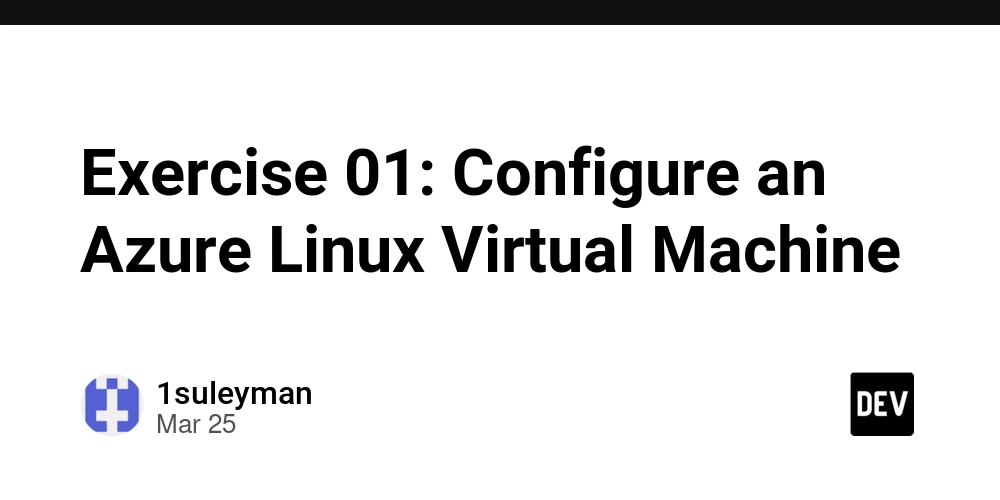Exercise 01: Configure an Azure Linux Virtual Machine
Introduction In this exercise, I learned how to create a Linux-based virtual machine (VM) in Azure, connect to it using SSH, and install the Nginx web server. This exercise helped me gain hands-on experience with the creation and management of Linux VMs, as well as performing basic administrative tasks such as installing OS updates and setting up a web server. Scenario For this task, I was tasked with setting up a web server for a new eCommerce website. This required provisioning a Linux VM, using SSH to securely connect to it, and then installing the Nginx web server. Lastly, I needed to ensure that the virtual machine was up-to-date and properly configured to serve web content. Skills Practiced: Using the Azure portal to create a Linux virtual machine. Connecting to the virtual machine via SSH. Installing the Nginx web service on the VM. Running OS updates on the Linux VM. Step-by-Step Guide Step 1: Use the Azure Portal to Create a Virtual Machine 1️⃣ Sign in to the Azure Portal First, I signed into the Azure portal here. 2️⃣ Create a Virtual Machine In the Azure portal, I searched for "Virtual Machines" and selected Create. I filled out the Basics tab as follows: Setting Value Subscription [Your Azure Subscription] Resource Group RG1 Virtual Machine Name VM1 Region East US Availability Options No infrastructure redundancy required Security Type Standard Image Ubuntu Server 24.04 LTS - x64 Gen2 Size Standard_DS2_v2 (2 vCPUs, 8 GB RAM) Authentication Type SSH public key Username adminuser SSH Public Key Source Generate new key pair SSH Key Type RSA SSH Format Key Pair Name VM1_key Public Inbound Ports None 3️⃣ Configure Disks, Networking, and Management For disks, I selected Premium SSD (30 GiB default). For Networking, I chose the default Virtual Network (VNet) and ensured Public IP was selected. I disabled auto-shutdown under Management. 4️⃣ Review and Create After reviewing the settings, I clicked Create and waited for the deployment to complete. Once completed, I clicked on Go to Resource to see the details of my newly created VM. Step 2: Connect to the Virtual Machine and Install OS Updates 1️⃣ Configure Network Security Group (NSG) to Allow SSH Before I could connect via SSH, I needed to configure port 22 (SSH) to allow access. I did this by navigating to the Network settings and adding a new Inbound port rule for SSH. 2️⃣ Connect Using SSH To connect to the VM, I used SSH with the key I generated earlier. Here's how I connected from my Mac terminal: chmod 400 ~/Downloads/VM1_key.pem ssh -i ~/Downloads/VM1_key.pem adminuser@ I replaced with the actual IP address of my VM from the Overview page in Azure. 3️⃣ Update the Operating System Once connected to the VM, I updated the OS by running these commands: sudo apt update sudo apt upgrade I confirmed the installation by typing 'Y' when prompted. Step 3: Install the Nginx Web Service and Test 1️⃣ Install Nginx I installed the Nginx web server with the following command: sudo apt install nginx When prompted, I typed 'Y' to continue with the installation. 2️⃣ Start Nginx I started the Nginx service using the command: sudo systemctl start nginx 3️⃣ Configure Nginx to Launch on Boot I made Nginx start automatically whenever the VM reboots by running: sudo systemctl enable nginx 4️⃣ Check Nginx Status I verified that the Nginx service was running with the command: service nginx status 5️⃣ Test Nginx To test Nginx, I opened a browser and navigated to http://. I should see the default Nginx welcome page. Challenges Encountered and Resolved Permission Issues with SSH Key: When I tried to SSH into the VM, I encountered the error: "Permission denied (publickey)." This was caused by incorrect file permissions for the SSH key. I fixed this by running the following command on my Mac: chmod 400 ~/Downloads/VM1_key.pem This ensured that the key was readable only by me, allowing SSH to work. SSH Connection Issues in Azure Cloud Shell: I initially attempted to connect via Azure Cloud Shell, but ran into issues because Cloud Shell cannot access local private keys. To resolve this, I switched to my Mac's Terminal and connected using the appropriate key file. Key Learnings 1️⃣ Azure Virtual Machines Azure VMs are on-demand scalable computing resources. I learned how to create and configure a Linux-based virtual machine using the Azure portal, specifying details such as size, image, and authentication method. 2️⃣ SSH Access to Linux VMs SSH is a secure method to connect to Linux VMs in Azure. I successfully configured the VM to allow SSH access, created a new SSH key, and connected to the VM from my local machine. 3️⃣ Managing the VM with OS Updates I installed essentia

Introduction
In this exercise, I learned how to create a Linux-based virtual machine (VM) in Azure, connect to it using SSH, and install the Nginx web server. This exercise helped me gain hands-on experience with the creation and management of Linux VMs, as well as performing basic administrative tasks such as installing OS updates and setting up a web server.
Scenario
For this task, I was tasked with setting up a web server for a new eCommerce website. This required provisioning a Linux VM, using SSH to securely connect to it, and then installing the Nginx web server. Lastly, I needed to ensure that the virtual machine was up-to-date and properly configured to serve web content.
Skills Practiced:
- Using the Azure portal to create a Linux virtual machine.
- Connecting to the virtual machine via SSH.
- Installing the Nginx web service on the VM.
- Running OS updates on the Linux VM.
Step-by-Step Guide
Step 1: Use the Azure Portal to Create a Virtual Machine
1️⃣ Sign in to the Azure Portal
First, I signed into the Azure portal here.
2️⃣ Create a Virtual Machine
In the Azure portal, I searched for "Virtual Machines" and selected Create. I filled out the Basics tab as follows:
| Setting | Value |
|---|---|
| Subscription | [Your Azure Subscription] |
| Resource Group | RG1 |
| Virtual Machine Name | VM1 |
| Region | East US |
| Availability Options | No infrastructure redundancy required |
| Security Type | Standard |
| Image | Ubuntu Server 24.04 LTS - x64 Gen2 |
| Size | Standard_DS2_v2 (2 vCPUs, 8 GB RAM) |
| Authentication Type | SSH public key |
| Username | adminuser |
| SSH Public Key Source | Generate new key pair |
| SSH Key Type | RSA SSH Format |
| Key Pair Name | VM1_key |
| Public Inbound Ports | None |
3️⃣ Configure Disks, Networking, and Management
- For disks, I selected Premium SSD (30 GiB default).
- For Networking, I chose the default Virtual Network (VNet) and ensured Public IP was selected.
- I disabled auto-shutdown under Management.
4️⃣ Review and Create
After reviewing the settings, I clicked Create and waited for the deployment to complete. Once completed, I clicked on Go to Resource to see the details of my newly created VM.
Step 2: Connect to the Virtual Machine and Install OS Updates
1️⃣ Configure Network Security Group (NSG) to Allow SSH
Before I could connect via SSH, I needed to configure port 22 (SSH) to allow access. I did this by navigating to the Network settings and adding a new Inbound port rule for SSH.
2️⃣ Connect Using SSH
To connect to the VM, I used SSH with the key I generated earlier. Here's how I connected from my Mac terminal:
chmod 400 ~/Downloads/VM1_key.pem
ssh -i ~/Downloads/VM1_key.pem adminuser@
I replaced
3️⃣ Update the Operating System
Once connected to the VM, I updated the OS by running these commands:
sudo apt update
sudo apt upgrade
I confirmed the installation by typing 'Y' when prompted.
Step 3: Install the Nginx Web Service and Test
1️⃣ Install Nginx
I installed the Nginx web server with the following command:
sudo apt install nginx
When prompted, I typed 'Y' to continue with the installation.
2️⃣ Start Nginx
I started the Nginx service using the command:
sudo systemctl start nginx
3️⃣ Configure Nginx to Launch on Boot
I made Nginx start automatically whenever the VM reboots by running:
sudo systemctl enable nginx
4️⃣ Check Nginx Status
I verified that the Nginx service was running with the command:
service nginx status
5️⃣ Test Nginx
To test Nginx, I opened a browser and navigated to http://. I should see the default Nginx welcome page.
Challenges Encountered and Resolved
- Permission Issues with SSH Key: When I tried to SSH into the VM, I encountered the error: "Permission denied (publickey)." This was caused by incorrect file permissions for the SSH key. I fixed this by running the following command on my Mac:
chmod 400 ~/Downloads/VM1_key.pem
This ensured that the key was readable only by me, allowing SSH to work.
- SSH Connection Issues in Azure Cloud Shell: I initially attempted to connect via Azure Cloud Shell, but ran into issues because Cloud Shell cannot access local private keys. To resolve this, I switched to my Mac's Terminal and connected using the appropriate key file.
Key Learnings
1️⃣ Azure Virtual Machines
Azure VMs are on-demand scalable computing resources. I learned how to create and configure a Linux-based virtual machine using the Azure portal, specifying details such as size, image, and authentication method.
2️⃣ SSH Access to Linux VMs
SSH is a secure method to connect to Linux VMs in Azure. I successfully configured the VM to allow SSH access, created a new SSH key, and connected to the VM from my local machine.
3️⃣ Managing the VM with OS Updates
I installed essential OS updates to keep the system secure and up-to-date. This is a crucial task for maintaining the health of the virtual machine.
4️⃣ Web Server Deployment
I learned how to install the Nginx web server and configured it to start automatically when the VM boots up. This is an essential skill for setting up web applications in a production environment.
Conclusion
This exercise provided me with practical experience in deploying and managing a Linux-based virtual machine in Azure. I gained hands-on skills in using SSH to securely connect to the VM, updating the operating system, and setting up the Nginx web server to serve content.
Through this, I now have a solid understanding of provisioning, managing, and securing a Linux VM in Azure, a key skill for deploying web applications in the cloud.




















































%20Abstract%20Background%20112024%20SOURCE%20Amazon.jpg)






















































































































![[The AI Show Episode 142]: ChatGPT’s New Image Generator, Studio Ghibli Craze and Backlash, Gemini 2.5, OpenAI Academy, 4o Updates, Vibe Marketing & xAI Acquires X](https://www.marketingaiinstitute.com/hubfs/ep%20142%20cover.png)
























































































































































































































































-Nintendo-Switch-2-–-Overview-trailer-00-00-10.png?width=1920&height=1920&fit=bounds&quality=80&format=jpg&auto=webp#)





















_Anna_Berkut_Alamy.jpg?#)













































































































![YouTube Announces New Creation Tools for Shorts [Video]](https://www.iclarified.com/images/news/96923/96923/96923-640.jpg)





































































![[Weekly funding roundup March 29-April 4] Steady-state VC inflow pre-empts Trump tariff impact](https://images.yourstory.com/cs/2/220356402d6d11e9aa979329348d4c3e/WeeklyFundingRoundupNewLogo1-1739546168054.jpg)





























































